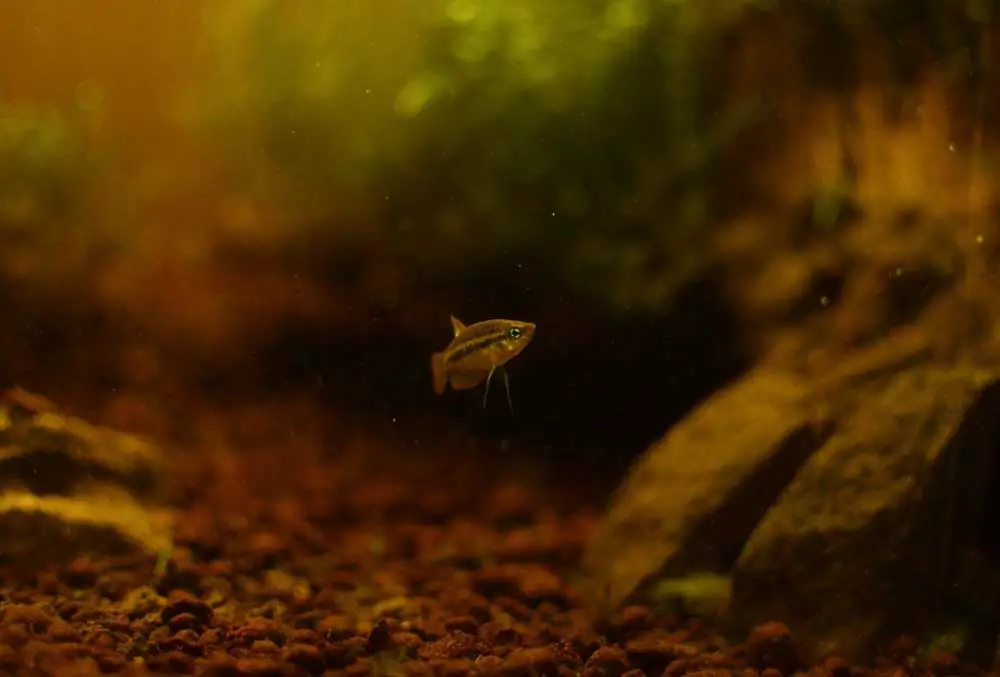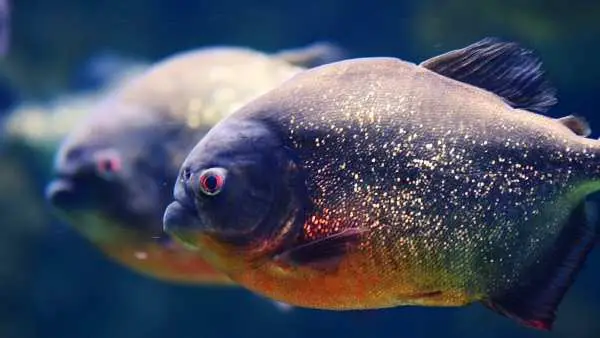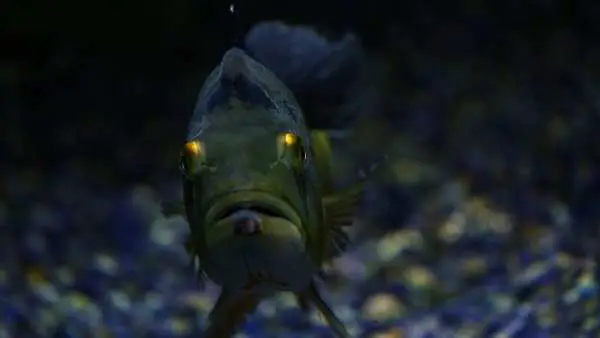If you are looking for a new aquarium to set up, you might consider a blackwater aquarium. Whilst this title might not give away much about the aquarium itself, these are interesting, and they can provide a unique addition to your home.
Choosing the type of aquarium can be difficult if you are not sure what you are looking for, but a blackwater aquarium is definitely something that you should consider.
To help you make a decision, we are going to tell you everything that you need to know about blackwater aquariums in this article.
What is Blackwater?

The Amazon River and its tributaries are classified as whitewater and blackwater. Whitewater habitats will have a natural pH of around 7.0, and the water will carry suspended particles and lots of nutrients. This water is quite clear.
However, blackwater habitats will have dark-colored and transparent water, which is caused by large amounts of dissolved humic substances in the water.
This is due to the fact that the rivers rise and extend into floodplains, and if the floodplain has debris, the water will become acidic. This causes a darker color, as the water is tainted by things like decomposing seeds, leaves, fruit, and wood.
In Brazil, this habitat is called - igapó or root forest. The twisted roots of the trees combined with humic acids will create a unique freshwater habitat that is home to more than 200 species of fish.
Why is a Blackwater Habitat So Dark?
The reason that the water is so dark is that when the water is mixed with logs, twigs, leaves, and more, they start to decay. This leads to a combination of bacteria and fungi, and chemical processes occur to start to break down the organic matter.
Humic substances that were once contained in the plant material will then be released into the water. Humic acids range between dark brown and black contributing to the changing water color and lowering the pH.
What is Classed As a Blackwater Aquarium?
You can create your very own blackwater aquarium by simulating the water chemistry of Amazonian blackwater. In order to achieve this, the water will need to be low in minerals and aquascaped with live plants, aquarium wood, and organic matter that will decompose over time.
As time passes on, the aquarium will age, which allows the decomposing plant material to release natural acids and more, which will cause the water to turn into a dark brown color.
A blackwater aquarium is very similar to a planted aquarium, and the most difficult part of creating one is maintaining a habitat for the plants as well as a controlled decomposition of leaf litter.
Fish that are accustomed to this type of water can be added to the aquarium to add color, movement, and interest to your new habitat. The fish will also add nutrients and contribute carbon dioxide to the plants. Together, this will create the perfect ecosystem.
What Fish Should I Add to a Blackwater Aquarium?
Even though you will need to focus lots of your energy on creating the perfect environment inside the aquarium, you will also need to choose fish that are going to thrive in this environment. Thankfully, there are lots of different fish to choose from.
Interestingly, there are more than 200 species of freshwater fish that live in natural blackwater environments, so there are lots of fish species to choose from.
You will need to ensure that you do your research before deciding to ensure that the fish you choose meet the size requirements of your tank. Some of the fish that you can introduce into your blackwater aquarium include:
- Tetras
- Geophagus
- Brycon species
- Firemouth cichlids
- Discus
- Pimelodus catfish
- Loricariid catfish
- Uaru
- Gouramis
- Apistogramma.
How to Create a Blackwater Aquarium
There is no one way that you have to follow to create your blackwater aquarium, but there are some things that you will need to keep in mind. The first thing you need to think about is the size of the tank, depending on how many fish you want to include and the size of these fish.

You can choose any size you want as long as you are prepared to put in the right amount of effort to maintain the environment. You should also do some research into the fish that you are choosing to find out how big they grow.
Substrate
Blackwater aquariums do well with a fine gravel instead of the sand that goes in lots of other aquariums. This will work well to anchor plants and provide a root zone. There are also lots of Amazonian fish that like to sift sand while looking for live foods. You can either choose a light-colored and natural gravel or a darker specialty substrate for planted aquariums.
Lighting Your Tank
Due to the environment, the blackwater environment is typically dimly lit, so lighting isn’t too much of an issue here. If you are not using live plants, then you can pretty much use any type of aquarium light for this purpose.
White lighting will typically work the best for allowing you to see into the dark-colored tank.
White LED lighting will also work to create light ripples throughout the tank, which kind of mimics sunlight passing through the debris in the tank. You can also get your hands on LED lights that provide you with the ability to change the color, and you can try out different colors to see which one works the best in the environment you have created.
Some lighting choices might bring out the colors of your chosen fish better than others will. It is also worth being aware of the fact that many aquatic plants will grow well under medium-brightness LED lighting.
Heating Your Tank
To efficiently heat your new aquarium, you should get your hands on a submersible heater. This will work to stabilize the temperature of the water. The temperature that you are aiming for will be between 75 and 80 degrees Fahrenheit.
Controlling the Water
The water is one of the most important aspects of the tank in a blackwater aquarium, and the water will need to be low in hardness and alkalinity. The ideal range is a 2 to 5-degree range. If you have hard tap water, then you are likely going to need to blend the hard water with reverse osmosis water to get the levels that you need.
The levels do not have to be exact, but you should try to get as close as possible. The hardness should be less than 8 degrees. This will mimic the water chemistry that can be found in Amazonian conditions and allow the pH to slowly drop as time goes on.
You will also need to consider the movement of the water, and you can achieve this with a hanging power filter in a smaller aquarium. This will typically create the movement in the water that you need. However, if you have a larger tank, then you may need a canister filter or power heads, which can be used to create a flow of water throughout the tank.
If you are raising live plants, you should try not to agitate the surface of the water too much, as this will rid the carbon dioxide that the plants need to survive. If there are no live plants in the water, then you can aerate the water as much as you want.
Filtering the Water
It is often recommended that you use a mechanical filter in your aquarium to catch any debris. You should make sure that you clean the different components in this filter at least once a month, and replace it if it stops working as it should. You should also know that activated carbon will remove some of the humic substances.
This is why you should only use activated carbon for around one week out of the month, as this will remove some of the humic substances, as well as anything else that is building up in the water where it is not wanted.
If you think that your tank has become too dark, then you might want to use more activated carbon, and change it weekly to reduce the level of staining in the water. Be mindful of how much you are using, as you don’t want to negatively affect the environment that you have worked so hard to create.
Additional Materials
To create the perfect blackwater aquarium, you will need to add some extra things into your tank. One of these things is any type of aquarium driftwood that will work well in your tank and not raise the pH level. Not only will this add to the overall aesthetic of the tank, but it will also give the fish a new place to explore.
Some aquarium woods will release tannins into the water, and you should do some research to find the type of wood that will work the best for your tank. One option to choose is Manzanita wood, which is pH neutral, and is a great addition to any blackwater aquarium.
You can also choose to include smooth stones and rough rocks to try and mimic the natural riverbed that would be found in natural blackwater environments. However, you will need to choose a type of rock that will not release calcium or alkalinity into the water, as this will disrupt the water and create a poor environment for your fish.
Some rock will also increase the pH by slowly releasing carbonate hardness into the water, so research is key when you are adding anything new into your tank.
If you are thinking of adding any leaves into your tank, then you will need to make sure to choose the right ones. Unfortunately, you can’t just pick up leaves off the ground and throw them into your tank, you will need to purchase specific ones.
A great type is Indian almond leaves, which are easy to get hold of online, and they are completely safe to use. Another option is alder cones, which are often used to increase the tannins in the water.
The following additions are both safe and effective to use:
- Pedunculate – Quercus robur
- Sessile oak – Q. petraea
- Turkey oak – Q. cerris
- Red oak – Q. rubra
- European beech – Fagus sylvatica
- Hawthorn – Crataegus monogyna
- Japanese maple – Acer palmatum
You can also get prepared liquid blackwater additives, but these might not always be able to provide the same benefits as the natural substances that can be created in your aquarium.
You should know that even if it makes your tank brown, it doesn’t necessarily mean that it is making the right changes to your tank’s environment. It is usually better to stick with natural plant matter instead.
How Many Leaves Should I Add To My Tank?
There is no exact number of leaves or cones that you should add to your blackwater aquarium, but as long as they are not toxic, you are not going to hurt your fish. A good rule to follow is 2 leaves per 10 to 15 gallons of water.

Dried leaves might take more than a day to soak up enough water to sink, and you should replace them every one to two months. It might take some time to get your ratios right, but it will get easier over time.
Should I Use Live Plants?
You don’t actually have to use live plants in your blackwater aquarium if you are building an environment that mimics a fast-moving stream. This is because plants wouldn’t usually grow here. If you do choose live plants, then you should choose medium to low-light types that will be able to thrive in your dimly lit tank.
What Should the pH Be in a Blackwater Aquarium?
In nature, the pH of the natural water would change a lot during just 24 hours. It will fluctuate throughout the day, and this is a normal and natural occurrence that is neither stressful nor harmful to the fish.
This means that your pH level does not need to be consistent or perfect at every point throughout the day.
In an aquarium that has a low alkalinity, it is normal for the pH to lower due to the natural acids that are released into the water. The humic acids will also help to lower the pH, but they are not strong acids, so they will not lower the pH if the alkalinity is high.
It is possible to run the tank below a pH of 6, but you should try to aim to keep the tank at a pH of around 6.5 to 7. You can do this by balancing the carbonate hardness in the tap water with the pH in your tank.
You can get your hands on a pH testing kit to keep an eye on the chemistry that is taking place in the water. These are recommended for blackwater aquariums, as you need to create quite a specific environment. You can also get water hardness testing kits, so you can find out more about the water you are using.
Many tropical fish will appear more colorful in an acidic environment when they are fed a blanched diet. It can take some time for fish to color-up, but this will usually occur in the right conditions.
There is also some evidence to suggest that captive fish that are exposed to humic substances will remain in better health and that they will heal more quickly on their own. There is also evidence that suggests that disease is less common in these conditions.
Aquaculture researches have found that natural humic substances can help to promote disease resistance and the healing of damaged fins and skin. This means that captive fish will remain healthier in a blackwater environment.
How to Maintain a Blackwater Aquarium
All aquariums will need to be maintained, and an Amazonian tank will benefit from water changes.
You will need to ensure that you are providing your fish with a correct and balanced diet, and ensure that there is build-up of sludge in the gravel. Another thing to keep an eye on is a build-up of algae or algae-promoting ingredients.
You should be sure to keep on top of cleaning the water every few weeks, and you should change at least 20% of the water each time.
If the tank is becoming too dark, then you need to change the water more frequently or increase the amount of water that is being changed. You can also get a gravel siphon to clean up the gravel at the bottom of the tank when needed.
Summary
Blackwater aquariums can be really interesting, and while they may present a variety of challenges, they will certainly be worth it in the end. You will need to be patient throughout the process.

